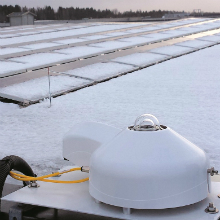The Norwegian solar energy industry
Norway produces about 56% of its energy requirements, including for transport, from renewable sources. The market, however, is dominated by hydroelectric power. The Norwegian solar industry is not so well developed, but the interest in solar energy is growing. Norway has no special financial incentives for solar PV installations, but the interest is driven by the building industry. The market for rooftop solar PV electricity generation is slowly developing.
About ASKO
ASKO is Norway’s largest wholesaler and supplier of groceries and delivers to the stores of parent company NorgesGruppen ASA. ASKO includes 13 regional companies with central warehouses, a cross-docking terminal at Vestby in Akershus, and 8 Storcash locations. With 600 trucks on the road every day ASKO is one of Norway’s biggest transport companies. ASKO has the ambition to become sustainable and climate neutral. They focus on energy efficiency initiatives and renewable resources.
Info on the power plant
ASKO needs a continuous supply of large amounts of electricity for its logistics and cold storage centres. The customized PV plant for self-consumption is a step closer towards their important goal; shifting entirely to renewable energies in order to become a climate neutral organisation.
With this pilot photovoltaic project, ASKO positions itself within Norway as a pioneer in the field of solar energy plants. The company uses the power particularly efficiently, with a self-consumption rate of 100%. The company also benefits from the ability to plan their electricity costs long-term.
The installed capacity of the plant is 370.5 kilowatts peak (kWp) with an expected production of 300 MWh per year. In 2017 they will expand the facility to an estimated annual production of 3.4 GWh.
How do they monitor the efficiency?
ITAS - Scanmatic Instrument Technology AS, the local Kipp & Zonen distributor, supplied the ASKO project with a full weather station including CMP10 pyranometers ventilated with the CVF4. The CMP10 is especially suitable for solar energy applications as it meets the ISO requirements for a Secondary Standard pyranometer and its maintenance demand is low. The ventilation unit was chosen to minimize maintenance (removing dust, dew and snow). The station also includes a Lufft V200A ultrasonic wind sensor, two Campbell Scientific 110PV thermistor to measure the rear of panel temperature and a Sommer SSR 200S snow load scale.
Since the solar industry is still at its beginning in Norway, the need for monitoring the panel efficiency is in focus. The department of Mathematical Sciences and Technology at the Norwegian University of Life sciences (10 km to the North) are working together with ASKO to monitor how well the plant is performing and comparing results with their own local references.
The plant will be completed by the end of the year and will provide 25 percent of the energy needed for the daily operations of the building.
